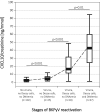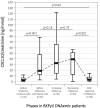Urine CXCL10 to Assess BK Polyomavirus Replication After Kidney Transplantation
- PMID: 37408094
- PMCID: PMC10664791
- DOI: 10.1097/TP.0000000000004712
Urine CXCL10 to Assess BK Polyomavirus Replication After Kidney Transplantation
Abstract
Background: Urine CXCL10 is a biomarker for renal allograft inflammation induced by rejection, urinary tract infection, or BK polyomavirus (BKPyV) replication. This study aimed to compare urine CXCL10 levels in different stages of BKPyV reactivation and to investigate urine CXCL10 as a biomarker for BKPyV replication.
Methods: We included 763 urine samples (235 patients) from an interventional, randomized trial obtained in the context of regular screening for urine CXCL10 levels. All urine samples had a complete urine sediment analysis, no rejection episode noted within 30 d before urine collection, and a urine decoy cell analysis was conducted within ±3 d.
Results: Urine CXCL10 levels were 2.31 ng/mmol in samples without BKPyV viruria, slightly rose to 4.35 ng/mmol with BKPyV viruria, and then markedly increased to 16.42 ng/mmol when decoy cells were detectable, but still in the absence of BKPyV DNAemia ( P < 0.001). The highest urine CXCL10 values were observed in samples with BKPyV DNAemia (median 42.59 ng/mmol). The area under the curve of urine CXCL10 levels to detect ≥3 decoy cells was 0.816. At a CXCL10 cutoff of 3 ng/mmol, the negative predictive value was 97%. The area under the curve of urine CXCL10 levels to detect BKPyV DNAemia was 0.882, with a negative predictive value of 99% at a CXCL10 cutoff of 3 ng/mmol.
Conclusions: Urine CXCL10 levels are already significantly elevated in BKPyV viruria (especially with decoy cell shedding) and further increase with BKPyV DNAemia. Low urine CXCL10 values can rule out the presence of ≥3 decoy cells and BKPyV DNAemia with high certainty.
Copyright © 2023 The Author(s). Published by Wolters Kluwer Health, Inc.
Conflict of interest statement
The authors declare no conflicts of interest.
Figures





References
-
- Hirsch HH, Knowles W, Dickenmann M, et al. Prospective study of polyomavirus type BK replication and nephropathy in renal-transplant recipients. N Engl J Med. 2002;2002:488–496. - PubMed
-
- Hirsch HH, Randhawa P; AST Infectious Diseases Community of Practice. BK polyomavirus in solid organ transplantation. Am J Transplant. 2013;13(Suppl 4):179–188. - PubMed
-
- Hirsch HH, Randhawa PS; AST Infectious Diseases Community of Practice. BK polyomavirus in solid organ transplantation—Guidelines from the American Society of Transplantation Infectious Diseases Community of Practice. Clin Transplant. 2019;33:e13528. - PubMed
-
- Egli A, Infanti L, Dumoulin A, et al. Prevalence of polyomavirus BK and JC infection and replication in 400 healthy blood donors. J Infect Dis. 2009;199:837–846. - PubMed
MeSH terms
Substances
LinkOut - more resources
Full Text Sources
Medical

